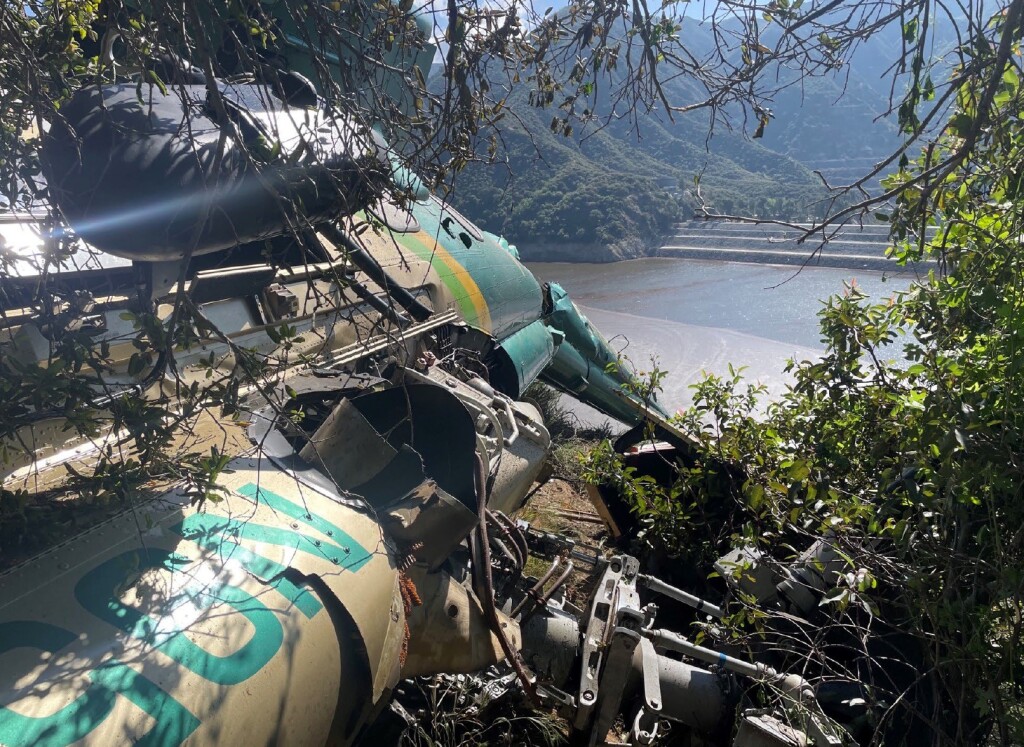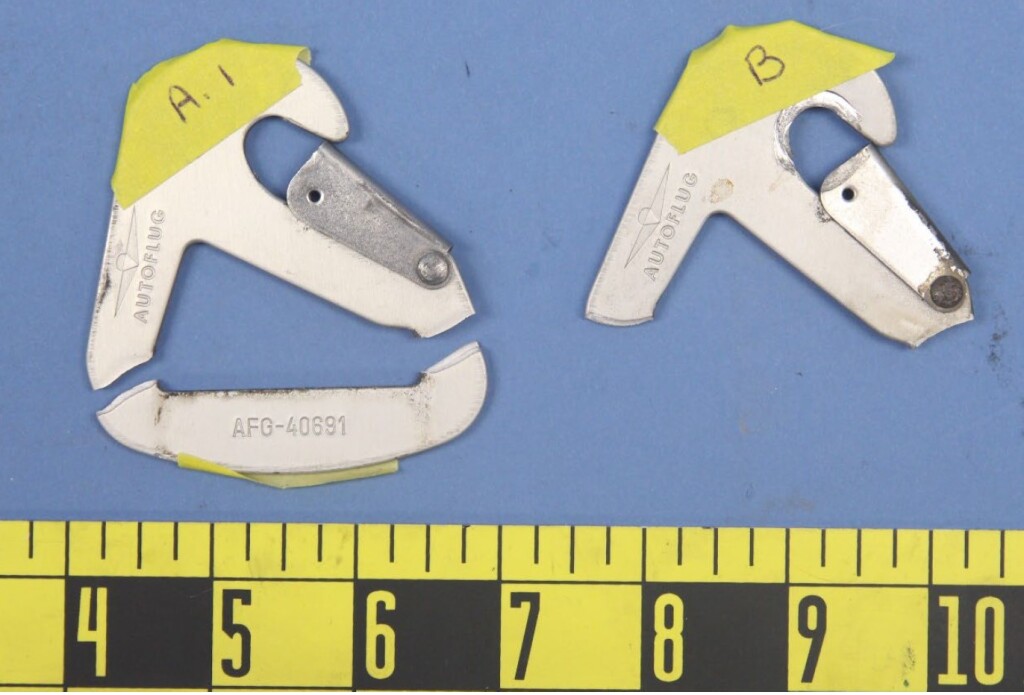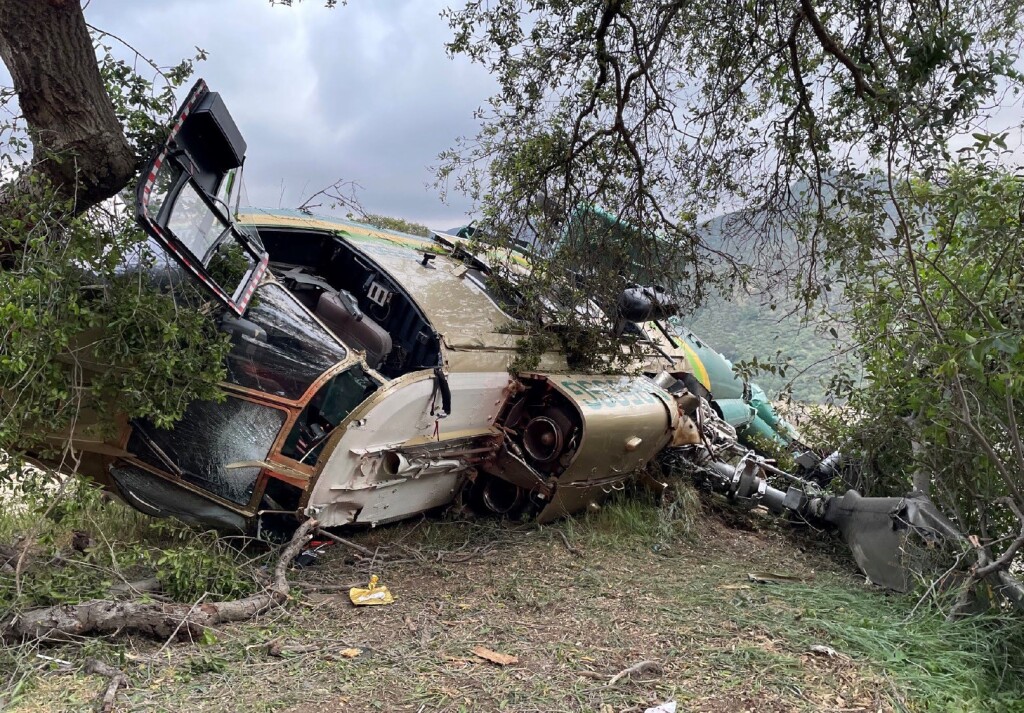Sheriff Super Puma Brownout Accident: NTSB Report (LASD AS332L1 N950SG)
On 19 March 2022, Airbus AS332L1 Super Puma N950SG of the Los Angeles County Sheriff Department (LASD) was destroyed in a brownout landing accident near Azusa, California. Four occupants received serious injuries, and the other two escaped with minor injuries.
The aircraft came to rest at a cliff edge. News Report VIDEO.

Wreckage of LASD Airbus AS332L1 Super Puma N950SG Air Rescue 5 after a Brownout Accident (Credit: LASD via NTSB)
In the short US National Transportation Safety Board (NTSB) safety investigation report, issued on 9 September 2022 and the associated public docket it is explained that the police helicopter, callsign Air Rescue 5, had been tasked to conduct a HEMS / air ambulance flight to transfer a patient from a road accident in a canyon in the Angeles National Forest. Oddly in the accident report form the LASD did not declare the applicable regulations a being ‘Public Aircraft’ but incorrectly as a ‘Part 91 Air Ambulance Flight’
The aircraft commander had 5,382 hours experience, 1243 on type. The co-pilot had 2,686 hours experience, 297 on type. There were also a crew chief (hoist operators), two medics and a UCLA doctor onboard.
The initial plan had been to land on the main road itself, but the space was filled by vehicles unable to progress due to the road accident. The crew then decided to land in an unmetalled turnout (or a dirt passing area) and conducted at least two low recce passes.
The crew chief (CC) called out a ‘stinger’ (tree) obstacle that the aircraft commander (PIC) acknowledged. In their interview with the CC:
The CC stated that the PIC said that he was going to stay close to the roadway in case they get into some brownout. The CC stated that he thought the PIC was ready for a brown out situation.
The CC stated that they started the approach and were kind of coming in a sideways angle facing the south toward the tree. He said the dirt wasn’t too bad and about 7 to 10 feet above the ground. He still had visibility and was in the process of clearing the rotors and the tail. He said that the called those out (rotors and tail clear).
The aircraft commander was maintaining the adjacent asphalt road as a reference through the cockpit bubble window.
[The CC] looked out toward the ground and noticed that they were drifting forward. He said, “Scotty you’re drifting forward, hold.” He said that they were continuing to move so he said it again, “Scotty you’re drifting forward, hold, I need you to hold right here.” He said that they continued to drift, and he called out the tree at 12 o’clock.
He said that it felt like they climbed a little bit, and that he could clearly see the blades moving toward the trees, then everything happened right after that.
The aircraft came to rest on its left side. The crew chief was thrown clear of the fuselage but restrained by his crew harness. Accident site VIDEO.

Wreckage of LASD Airbus AS332L1 Super Puma N950SG Air Rescue 5 after a Brownout Accident (Credit: LASD via NTSB)
The PIC (Pilot Flying) told the NTSB he had been aware of the brownout risk and:
They started the approach, and the PIC called out that he still had visual reference to the road. While about 5 feet above the ground, he heard one of the crew in the back call “hold.” The crew chief didn’t elaborate, he just said “hold.”
The PIC placed the helicopter into a hover. He lost all reference and announced that he, ”lost visual.” He then stated, “pulling up” or “climbing” (one of the two), with the intend of pulling straight up to get out of the dust. He stated that that was the last thing he remembered until he woke up in the cockpit.
The PIC stated that the CC “had just returned from a period of having not flown due to a knee surgery and was a little rusty with his commands”.
When the PIC spoke with the CC after the accident, the crew chief agreed that he should have elaborated as to why he said hold. The PIC stated that the crew chief still had visual references and observed the helicopter still moving forward, and that was why he called hold.
The PIC was knocked unconscious and woke onto of the co-pilot. Both brackets of the 265 lb (120 kg) PIC’s seat belt had broken. He had…
…heavy bruising on his lower body [and] his head hit the upper console, and the helmet protected his head.
The NSTB lab report conforms the seat belt clips failed in tensile overload.

LASD Airbus AS332L1 Super Puma N950SG Air Rescue 5 Brownout Accident: PIC’s Failed Seat Belt Clips (Credit: NTSB)
The NTSB make no further comment in their accident report. UPDATE 8 July 2023: A similar failure occured in this accident: BK117 Offshore Medevac CFIT & Survivability Issues
The NTSB Probable Cause
With very little prior analysis the NTSB state the probable cause was:
The pilot’s failure to maintain clearance from a tree after encountering brownout conditions and a loss of visual reference during the approach to land.
No recommendations are made (as sadly common in both rotorcraft and non-fatal NTSB accident reports).
The 2012 NATO RTO Technical Report TR–HFM–162 Rotary-Wing Brownout Mitigation: Technologies and Training describes brownout as “the condition where there is little or no out-the-cockpit window visibility caused by dirt and dust being stirred up by the rotor downwash and then re-circulated by the rotor blades of a helicopter during taking off or landing in an arid climate”.
Brownout VIDEO.

Wreckage of LASD Airbus AS332L1 Super Puma N950SG Air Rescue 5 after a Brownout Accident (Credit: LASD via NTSB)
Safety Resources
The European Safety Promotion Network Rotorcraft (ESPN-R) has a helicopter safety discussion group on LinkedIn. You may also find these Aerossurance articles of interest:
- AW139 Brownout Accident with the Nigerian VP Aboard
- HEMS A109S Night Loss of Control Inflight
- Inadvertent PTT Pedal Input Causes Tail Rotor Tailboom Contact
- US Fatal Night HEMS Accident: Self-Induced Pressure & Inadequate Oversight
- BFU Investigate S-76B Descending to 20ft at 40 kts En Route in Poor Visibility
- Air Ambulance A109S Spatial Disorientation in Night IMC
- A HEMS Helicopter Had a Lucky Escape During a NVIS Approach to its Home Base
- Air Ambulance Helicopter Struck Ground During Go-Around after NVIS Inadvertent IMC Entry
- US Air Ambulance Helicopter Hospital Heliport Tail Strike
- NYPD B429 Accident at Manhattan Heliport “Overapplication of Flight Controls”
- Air Ambulance B407 Hospital Helipad Deck Edge Tail Strike During Shallow Approach
- Air Methods AS350B3 Air Ambulance Tucson Tail Strike
- NTSB on LA A109S Rooftop Hospital Helipad Landing Accident
- Air Ambulance Leaps into Air: Misrigged Flying Controls
- US Air Ambulance Near Miss with Zip Wire and High ROD Impact at High Density Altitude
- Hanging on the Telephone… HEMS Wirestrike
- Air Ambulance Helicopter Downed by Fencing FOD
- Ambulance / Air Ambulance Collision
- Beware Last Minute Changes in Plan
- Grand Canyon Air Tour Tragic Tailwind Landing Accident
- Pedestrian Seriously Injured by Air Ambulance Landing at Melbourne Hospital
- UPDATE 19 November 2022: Whiteout During Avalanche Explosive Placement
- UPDATE 8 July 2023: BK117 Offshore Medevac CFIT & Survivability Issues
Also see our review of The Field Guide to Understanding Human Error by Sidney Dekker presented to the Royal Aeronautical Society (RAeS): The Field Guide to Understanding Human Error – A Review

Recent Comments